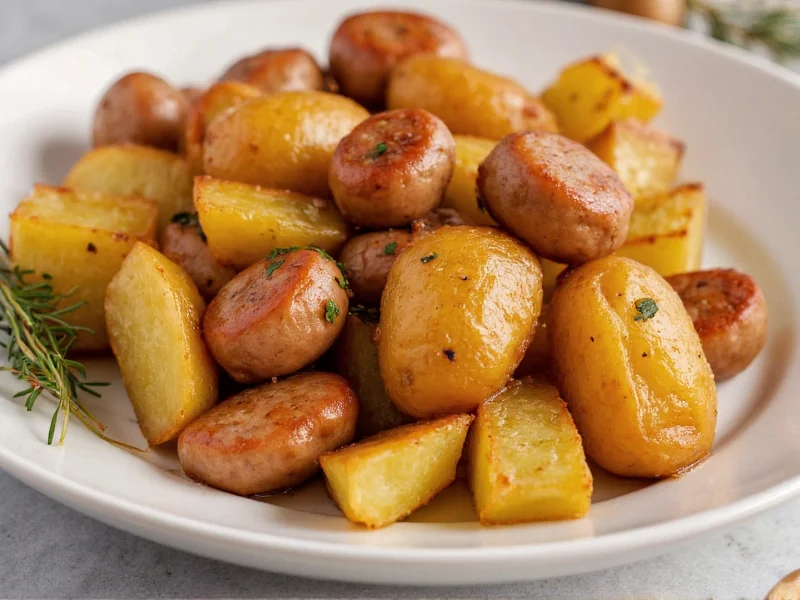Why Potatoes and Sausage Make Perfect Cooking Partners
Potatoes and sausage form one of cooking's most reliable duos for good reason. The natural starchiness of potatoes balances sausage's savory richness, creating meals that satisfy without requiring gourmet skills. When selecting ingredients, choose firm waxy potatoes like Yukon Gold for boiling or roasting, and opt for smoked sausage varieties that hold their shape during cooking. This combination works across multiple cuisines—from German bratwurst potato bakes to Spanish patatas bravas with chorizo.
Essential Ingredients Guide for Perfect Results
Selecting quality components makes the difference between ordinary and exceptional potato sausage dishes. Understanding which varieties work best prevents common cooking mistakes that lead to mushy potatoes or dry sausage.
| Ingredient | Best Choices | Avoid |
|---|---|---|
| Potatoes | Yukon Gold, Red Bliss, Fingerling | Russets for boiling (use for roasting) |
| Sausage Types | Smoked kielbasa, Andouille, Italian sausage | Premarked sausage with fillers |
| Flavor Enhancers | Fresh herbs, garlic, smoked paprika | Excessive salt (sausage is already seasoned) |
5 Tested Potato and Sausage Recipes You'll Make Regularly
One-Pan Smoked Sausage and Potato Skillet
This 35-minute weeknight solution delivers crispy potatoes and perfectly browned sausage without multiple dishes. Cut 1.5 pounds Yukon Gold potatoes into ½-inch cubes and parboil for 5 minutes. Meanwhile, slice 12 ounces smoked kielbasa into coins. Heat olive oil in a large cast-iron skillet over medium-high heat. Add potatoes in a single layer and cook undisturbed for 8 minutes until golden. Flip potatoes, add sausage, and continue cooking 15 minutes until potatoes are tender. Finish with fresh thyme and a splash of apple cider vinegar.
German-Style Potato and Sausage Casserole
Authentic enough for Oktoberfest yet simple for weeknights, this layered casserole features sliced potatoes, bratwurst, and caramelized onions. Thinly slice 2 pounds potatoes and 1 large onion. Brown 4 bratwurst links in a skillet, then slice. Layer half the potatoes in a greased baking dish, followed by half the onions, sausage, and ½ cup chicken broth. Repeat layers, cover, and bake at 375°F for 40 minutes. Uncover and bake 15 more minutes until potatoes pierce easily with a fork.
Breakfast Potato Sausage Hash with Fried Eggs
Morning meals don't get better than this protein-packed hash. Dice 1.5 pounds red potatoes small for quick cooking. Cook 8 ounces breakfast sausage in a large skillet until browned, then remove. Sauté diced bell peppers and onions until soft, then add potatoes with ¼ cup water. Cover and cook 12 minutes until potatoes soften, then uncover and crisp. Return sausage to skillet, season with smoked paprika, and top with fried eggs.
Proven Cooking Techniques for Perfect Results
Achieve restaurant-quality potato sausage dishes at home with these professional techniques. Parboiling potatoes before roasting creates crispy exteriors with tender interiors—simmer cubed potatoes for 5-7 minutes until slightly tender but still holding shape. When browning sausage, resist overcrowding the pan which causes steaming instead of searing. For meal prep friendly versions, roast potatoes and sausage separately then combine when serving to maintain optimal texture.
Serving Suggestions and Smart Variations
Elevate your potato sausage creations with these pairing ideas. Serve skillet dishes with quick-pickled red onions for brightness, or accompany casseroles with steamed green beans tossed in lemon zest. For healthier versions, replace half the potatoes with cauliflower florets while maintaining the same cooking method. Vegetarian adaptations work well using plant-based sausage alternatives paired with additional mushrooms for umami depth. Leftovers transform beautifully into potato sausage frittatas or stuffed into bell peppers for a second meal.
Frequently Asked Questions
Can I use frozen potatoes for sausage and potato recipes?
Yes, but with adjustments. Frozen diced potatoes work best in soups or casseroles where texture matters less. For skillet dishes requiring crispness, thaw completely and pat dry before cooking to remove excess moisture that prevents browning.
How do I prevent potatoes from becoming mushy when cooking with sausage?
Parboil potatoes just until slightly tender before finishing in the skillet, and avoid stirring too frequently. Cut potatoes to uniform sizes and choose waxy varieties like Yukon Gold that hold their shape better than starchy russets during cooking.
What's the best way to reheat potato and sausage dishes?
Reheat skillet dishes in a hot oven-safe pan at 350°F for 10-15 minutes to restore crispness. Microwave reheating makes potatoes soggy—when necessary, cover with a paper towel and heat in 30-second intervals, stirring once. Add a splash of broth if needed for moisture.
Which sausage varieties work best for potato recipes?
Smoked kielbasa provides classic flavor for American and German dishes, while Andouille adds Cajun heat to potato soups. For breakfast hashes, use maple-flavored breakfast sausage. Avoid highly processed sausages with excessive fillers that break apart during cooking.











 浙公网安备
33010002000092号
浙公网安备
33010002000092号 浙B2-20120091-4
浙B2-20120091-4